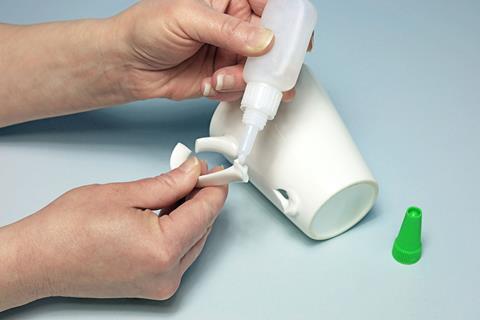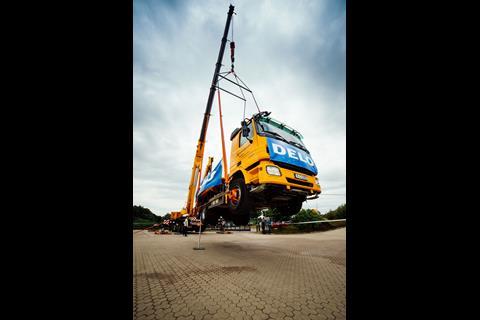Find out about the world’s strongest glue and how adhesives bond things together

Glue helps hold our modern world together. But what’s the best glue to bond your projects, broken mug, or fingers, together? It turns out the answer is a little stickier than just grabbing the nearest pot to hand.
What causes something to be sticky?
There are lots of sticky substances in nature, such as sugary, water-based tree sap. Interactions between molecules – intermolecular forces – usually cause this stickiness, rather than intramolecular chemical bonding. For example, water molecules are naturally adhesive because of their polarity. Oxygen, in the centre of the molecule, has two lone pairs of electrons, which are attracted to the nearby hydrogen atoms of other water molecules. These molecules form hydrogen bonds – a type of intermolecular force. As each water molecule can form four hydrogen bonds (one for each hydrogen and two from the lone pairs of electrons on the oxygen atom), this makes water sticky.
Don’t try this at home, but some trauma doctors use specially formulated medical glue to help close wounds
Van der Waals forces are another type of intermolecular force. They rely on a large surface area and are the reason a gecko’s feet can stick to a wall. If you want to know more, the book Sticky by Laurie Winkless is a great place to start.
There are lots of sticky substances in nature, such as sugary, water-based tree sap. Interactions between molecules usually cause this stickiness, rather than any kind of chemical bonding. For example, water molecules are naturally adhesive because of their polarity. Oxygen, in the centre of the molecule, has two lone pairs of electrons, which are attracted to the nearby hydrogen atoms of other water molecules. These molecules form hydrogen bonds – a strong type of intermolecular force. As each water molecule can form four hydrogen bonds (one for each hydrogen and two from the lone pairs of electrons on the oxygen atom), this makes water sticky.
Don’t try this at home, but some trauma doctors use specially formulated medical glue to help close wounds
Van der Waals forces are another type of intermolecular force. They rely on a large surface area and are the reason a gecko’s feet can stick to a wall. If you want to know more, the book Sticky (bit.ly/3L50pxX) by Laurie Winkless is a great place to start.
A brief history of glue making
Humans have been making glue for about 200,000 years. For most of this time, we made the glue by blending naturally sticky plant substances together, but by 2000BC we had learned to make glue from dead animals, such as horses and cows. We formed these glues by rendering – boiling down the connective tissue of animals – to obtain collagen. In fact, the word collagen comes from the Greek kolla, which means glue.
Collagen is a long, fibrous chain made of amino acids connected to other chains by hydrogen bonds, which then chemically bond with the surface you apply them to. As these long polymer chains are able to stretch a little, the glue isn’t brittle and doesn’t snap – so it turns out the secret for many types of glues isn’t just down to being sticky, but also being a little flexible, too.
Synthetic glues
Today’s best glues still rely on these long chains, but don’t use animal products. In the 20th century, companies began to develop glues using synthetic polymers. These also bond chemically with surfaces but form much stronger bonds. Ethyl 2-cyanoprop-2-enoate, the main component of adhesives such as Super Glue, is a great example. Manufacturers in the US initially created it to try to make plastic gun sights during the second world war, but they soon abandoned the glue as it was so sticky. The US Army did find a use for Super Glue during the Vietnam war, though. Medics used the adhesive to patch up bullet wounds and stop soldiers from bleeding to death. We don’t recommend you try this at home, but some trauma doctors use specially formulated medical glue to help close wounds.
Just three grams of the world’s strongest glue could hold a staggering 17.5 tons!
Synthetic glues work in different ways depending on the job they’re trying to do. Some, such as plastic glues for modelling, come in a solvent which evaporates when you expose it to air and makes them harden as they dry. The strongest glues tend to be resins, which we often form by mixing two different components together. This causes an exothermic chemical reaction, creating strong molecular bonds that will happily stick almost anything together.
It’s unsurprising, then, that the world’s strongest glue is an epoxy resin. DELO MONOPOX, made by the German adhesives company DELO, currently holds the Guinness World Record for the heaviest weight lifted by glue. This isn’t available to buy, as it’s a specially formulated version of an industrial-strength glue, made to be extra strong through additional fillers and a heat treatment. In 2019, DELO glued a steel cylinder to a crane arm and truck filled with concrete slabs. They extended the crane arm 40 metres into the air, lifting the truck one metre off the ground. Overall, just three grams of the world’s strongest glue could hold a staggering 17.5 tons!
It’s unsurprising, then, that the world’s strongest glue is an epoxy resin. DELO MONOPOX, made by the German adhesives company DELO, currently holds the Guinness World Record for the heaviest weight lifted by glue (bit.ly/3RFEZv2). This isn’t available to buy, as it’s a specially formulated version of an industrial-strength glue, made to be extra strong through additional fillers and a heat treatment. In 2019, DELO glued a steel cylinder to a crane arm and truck filled with concrete slabs. The company extended the crane arm 40 metres into the air, lifting the truck one metre off the ground. Overall, just three grams of the world’s strongest glue could hold a staggering 17.5 tons!
Keep your eyes glued to the screen and watch this TikTok:
@royalsocietyofchemistry A #glue so strong it could lift a truck!? Sounds impossible, right? But there are some specically chemically formulated glues that can do this. You'll be glued to your screen for this video, as Jo explains the different ways glues can form chemical bonds that make them super strong and stick anything to anything. (How many times can we use the word glue in a paragraph 😂) #LearnOnTikTok #chemistry #sciencetok ♬ sail away (instrumental) - lovelytheband
Kit Chapman
Keep your eyes glued and watch the TikTok: bit.ly/4bLxLwX

















No comments yet